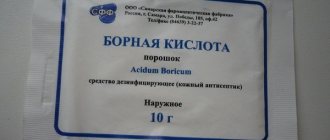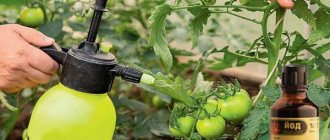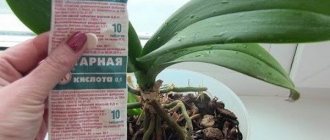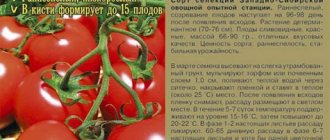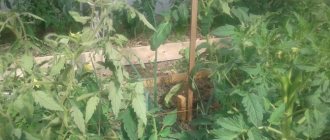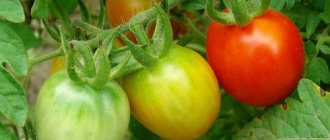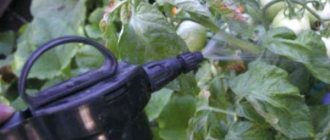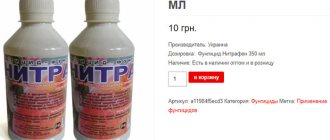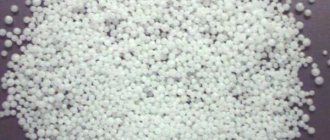Many garden crops require micro and macroelements from the soil for normal growth and development, and in sufficient quantities.
The quantity and quality of the harvest directly depends on this. Dear readers!
For you, we have created communities on social networks in which useful articles and interesting ideas are published several times a day! Subscribe and receive useful content in a convenient format! If we talk about tomatoes, it is recommended to treat them with a solution of boric acid several times during the growth and flowering period in order to increase productivity and carry out simple prevention of diseases and the proliferation of harmful insects.
The unique and main quality of boron for garden crops is that it allows you to more effectively accumulate useful minerals from the soil . In addition, it has long been noticed that after treatment with boric acid, tomatoes become better in taste, since more sugars accumulate in them. And these are not all the obvious advantages of using this simple, affordable tool.
Boric acid for tomatoes
It turns out that treating tomatoes with boric acid is nothing more than another stage of feeding garden crops. Nowadays, when most soils are severely depleted, especially its upper layers, the importance of adding boron to the soil is only increasing.
Using boric acid for tomatoes
It is known that fertilizing vegetable crops with is especially useful. For comparison, cereals, for example, absorb 10 times less boron than dicotyledonous plants.
And tomatoes and cucumbers, with sufficient accumulation of boron, significantly increase their yield. In the case of adding boric acid to tomatoes, two methods of feeding are widely used:
- The entire above-ground part of the plant is treated with a solution of boric acid.
- The same solution can be used for root feeding.
Interesting! It is believed that simply spraying the above-ground parts of tomatoes with boric acid is better , since the production of chlorophyll increases, the stem and root become stronger, and the plant better resists diseases and pests in general.
Beneficial features
In the natural environment, boron is practically never found in a free state. Plants obtain this element necessary for their development from salts contained in the soil. It has long been known that boron in tomatoes affects:
- flowering productivity;
- reduction in the number of empty ovaries;
- resistance of fruits to unfavorable conditions (in particular, high humidity);
- increased sugar content in fruits;
- reducing the risk of tomato late blight;
- better preservation of fruits after harvest.
This is interesting ! Boron, by the way, is found in many fertilizers and in a free state too. But the most common, affordable and simplest treatment agent is boric acid.
It is also known that boron accumulates very poorly in the soil and is easily washed away during rains or irrigation. This must be taken into account, so tomatoes will have to be processed relatively often.
The optimal amount of boron in a garden crop can significantly improve many internal processes and the synthesis of minerals in general . Thus, the absorption of nitrogen from the soil is significantly improved. In the case of tomatoes and cucumbers, boron allows cells to divide faster, which is why the fruits ripen faster and are larger.
In addition, boron helps improve the metabolism of carbohydrates and proteins, affects the efficiency of pollination and fertilization of ovaries at the time of flowering.
The role of boron in the growing season of tomatoes
During the growing season of tomatoes, boron:
- takes part in the construction of vegetable cell walls;
- controls the supply of calcium to the plant. A lack of this element can cause a disease such as blossom end rot;
- has a positive effect on the growth of each part of the tomato, as it is responsible for the process of growth of the tips of stems, leaves, and roots;
- affects the rate of formation of new cells;
- controls the process of transporting sugar from ripe tomato points to developing ones;
- helps the growth of fruits, the formation of new buds, and also promotes successful pollination of plants;
- takes part in the process of photosynthesis.
Harm
But boric acid can cause significant harm to plants, even to the point of complete death. The harmful effects are associated exclusively with overdoses . Excess boron causes leaf burns, which quickly begin to dry out and fall off. Thus, the entire plant cannot easily tolerate high concentrations of applied boron-based fertilizers.
This means that it is necessary to closely monitor the contents of the mixtures and use them in the exact concentration indicated on the package or recommended in the recipe. Also, boric acid should not be used more often than recommended by known treatment methods.
Useful tips
First of all, try to spray correctly and avoid common mistakes:
- Do not increase the dosage: by using 2 times more of the drug, you will not make the tomatoes better, but will simply get a different effect - for example, instead of strengthening the ovaries, you will kill pathogenic microflora or pests.
- Apply the product where action is required: fertilizing with boron from the roots can rise to the leaves, but never vice versa.
- Expand the range of drugs used. When people hear that a certain product is good, they assume that its application is enough for a good harvest, but combinations of drugs and processing methods give a much better effect.
Video: Treatment of tomatoes with boric acid to increase yield
Signs of boron deficiency
As a rule, boron deficiency can be easily determined by the appearance of the tomato. Experienced gardeners notice the need for boron treatment even faster.
- Firstly, a lack of minerals demonstrates a weakening of the upper part of the bushes.
- When the external environment is especially poor in boron, the upper shoots begin to curl, and in the worst case, dry out and fall off.
- Also, on tomatoes that are not treated in time with a solution of boric acid, many empty flowers form.
- At later stages, dry spots form not only on the leaves, but also on the fruits.
In general, you can understand that a tomato lacks boron if only by the fact that the plants look weak, stunted, most of them are sick at all stages of growth and do not take root well.
Signs of excess boron
On the other hand, any types of fertilizing are harmful even when they are applied too often and abundantly. It has long been noted that tomatoes can also suffer from an excess of boron. Basically, this is expressed:
- The leaves acquire a glossy shine - exactly the same as when there is an excess of nitrogen in the plant or soil.
- Dry spots bordered by concentric circles begin to appear on the leaves. If you do nothing (namely, water the plant more often and exclude fertilizing), then the entire leaf blade is quickly affected until it completely dies.
- The leaves become not flat, but curved in the middle like a dome.
In most cases, an excess of boron does not appear immediately. First of all, the old leaves suffer (dry parts appear) or the top of the bush. Only then does the rest of the bush wither, right down to the stem. So the problem can be noticed in time and the bushes can be saved.
Boric acid as a fertilizer and food for tomatoes
Boric acid is rightfully considered the simplest option for feeding tomatoes at different stages of growth.
Preference is given to this product mainly because it is often found on sale and is also low in price. At the same time, the efficiency of boron absorption by tomatoes when treated with boric acid is high.
The optimal periods for fertilizing tomatoes with boron are the time of growing seedlings, transplanting to open ground, and flowering.
Important condition. Spraying the aboveground part of a tomato should be carried out in the early morning, evening or in cloudy weather, since bright sun in combination with boron can lead to burns of leaf plates, stems, and fruits.
Advantages and disadvantages of using the product
Boron for this vegetable is an important element in its development, so if there is a shortage of it, it will seriously affect the development of tomatoes. Boron can significantly increase flowering and also prevent fruit rotting during periods of high humidity.
When using this drug, yield, as a rule, increases by 20%, and taste also improves significantly.
Procedures for spraying tomatoes with boron allow the vegetable to better absorb minerals and organic substances, which is important, especially when it comes to growing at home, for example, on a balcony. So, such vegetables are more sensitive and, as a result, need more nutrition. While the bush is being treated with boric acid, the risk that the vegetable will be affected by late blight is significantly reduced.
If we talk about the disadvantages, boron in excess in the soil is quite dangerous. For example, it can cause burns to the lower leaves and drying out of the leaves at the edges. That is why, if you decide to use the drug, carefully monitor the required dosage so that all proportions correspond and do not exceed the permissible limits.
Boric acid against pests
Another positive quality from the use of boric acid is pest control , which, by the way, tomatoes are very fond of.
- Boron is used as a poison against ants. Just pour the solution before entering the anthill. You can soak sugar, honey, and other sweets in a solution of boric acid that will attract insects.
- Simply spraying the bushes will help in the fight against aphids and woodlice. It is recommended to dilute 1 g. acids per 1 liter. water.
- Boric acid can even help against mole crickets. In this case, you should steam 1 kg of grain and mix it with a tablespoon of acid. After which the finished bait is laid out in different places in the garden.
Advice! It is better not to treat pests during the hottest part of the day in bright and active sun, because the effect of boron can be the opposite; the drug will have a detrimental effect not only on pests, but also on plants.
Tillage
Liquid boric acid
A solution of boric acid is also used to treat the soil if its composition is very poor and does not have a sufficient amount of components useful for the growth of cultivated plants. To prepare a working solution, you need to mix 0.2 g of powder with 1 liter of water. After spilling the solution, the ground is thoroughly loosened.
Such soil treatment is carried out only in those places where it is known for sure that there is a lack of boron in the composition:
- soil that has undergone liming;
- wetlands;
- soddy-podzolic layer.
A composition is used at the rate of 1 bucket of solution per 10 sq.m. area. After such treatment, the soil becomes fertile and rich in microelements important for the growth of cultivated plants.
How to dilute boric acid for spraying tomatoes
The normal ratio of boric acid dissolution in water for fertilizer is no more than 2 g. active substance per 1 liter. hot water ( boron dissolves without residue in water from 70 oC ).
If we are talking about treatment against insect pests , then the dosage will be effective even when diluted from 1 g. for 1 l. water .
Among other things, there are quite a lot of recipes for combining boric acid with other substances useful for the growth of garden crops.
Iodine solution
Mixtures with iodine have also proven effective in processing tomatoes. Basically, iodine is used to disinfect and increase the immunity of tomatoes .
The first treatments (at the stage of seedlings and ovary formation) do not interfere with the addition of boric acid. But then, when the bushes have grown and the tomatoes begin to ripen, you can carry out complex feeding of the plants by simply watering them at the root.
The mixture is prepared by adding 5 liters. hot water 3 kg wood ash. After this, you need to wait for it to cool and pour out a full bottle of iodine (10 ml) and 10 grams. boric acid.
Further, the mixture cannot be added in its pure form, but diluted in a ratio of 1 to 10 with clean water.
Solution with potassium permanganate
Manganese solution can be used to treat tomato seeds before planting..
The solution is prepared from 0.5 g. boric acid powder per 1 liter. hot water (at least above 55С). A drop of potassium permanganate (about 1 gram) is added to it. By the way, it is better to put the seeds in a gauze bag so that they do not float up.
Soaking time is from 12 to 24 hours immediately before planting.
This technique significantly improves seed germination, hardens future tomatoes and has a positive effect on yield.
Other recipes
If there is a problem of shedding of ovaries on already mature tomatoes , then it is recommended to dilute a weak solution of boric acid: 1 g. for 10 l. warm water. It is noteworthy that with this method of treatment, you should spray only the ovaries and the first buds of flowers, trying not to grab the leaves or stem.
By the way, this method is perfect for pollinating plants and stimulating better growth in a greenhouse, where there are not enough insects for the natural spread of pollen.
If tomatoes suffer from late blight , then boric acid will help here too. To do this, dilute 1 teaspoon per 10 liters. warm water. You need to roughly understand that a level teaspoon contains approximately 5 grams. powder. If boric acid was purchased in bags, then it is usually packaged in 10 grams. That is, you need to use half the package.
↑ When to fertilize
The microelement is added to the soil before planting seedlings or a solution is made. Seed material is dipped into it and sprouts and grown tomato bushes are sprayed. The dose of the solution depends on the stage of development at which the plant is located.
↑ Soaking seed material with boron solution
A solution of boric acid acts as a growth stimulator and disinfectant for seeds. For soaking, prepare the following solution: half a gram of powder per 1 liter of warm water. Seeds should be in the liquid for 24 hours. Then the seeds are washed from the solution with running water, dried and planted.
↑ Pre-planting soil treatment
Boron is applied to the ground before planting bushes. In a greenhouse or in open ground, the solution will help save tomato bushes from fungus and pests. Summer residents advise pre-treating the bed when the soil is sandy, acidified or wet. Information! Boron powder must not be added to the ground in dry form.
To treat the soil, boric acid is diluted at the rate of 10 grams per bucket of water. 1 liter of solution is enough for 1 m². The product is applied by direct watering.
As an option: when planting seedlings, pour 2 liters of a working solution of boric acid into each hole. It is prepared as follows: add 200 ml of concentrated solution to 1.8 liters of water (1 gram of powder is needed for 1 liter of water).
↑ Applying boron solution under the root
Watering a boric acid solution under the root system is necessary when there is a clear lack of boron. Root feeding can only be done once per season. When it rains soon after application, fertilizing can be repeated.
For feeding, boron powder is used in the amount of 1 g per 1 liter of warm water. Apply 1 liter of solution to each adult bush. Water early in the morning or late evening. The effect of fertilizing can be seen after 2 weeks.
↑ Spraying tomatoes with boric acid on leaves
The result of spraying on the leaves is noticeable after 1-4 days. Spraying is carried out as a preventive measure against fungal infections, as well as to compensate for the lack of boron. Foliar feeding is good because you can adjust the boron nutrition of tomatoes during the growing season. Timing and standards, as well as application technology, are key success factors. The consequences of being late or “overdosing” on boron are often very unpleasant.
The foliar feeding option is considered the most effective. The microelement is instantly absorbed through the pores, penetrating into the plant tissue.
During spraying, it is important to treat not only the upper part of the bush, but also the lower tier of leaves, and their inner side. Fertilizing is carried out only in dry weather, spraying the plants early in the morning or in the evening.
The solution is prepared as follows: 1 g of powder is dissolved in two liters of water. Gardeners recommend adding laundry soap to the water for better results and to prevent the solution from being washed off longer.
Against fungi, especially in rainy summers, the effect of boron is enhanced by iodine. Add a few drops of alcoholic iodine tincture to the prepared solution. This way the plant will be enriched with two microelements at once. For one adult bush, use 100 ml of solution.
Dosage, proportions and processing steps
The use of boric acid solution should be no more than once every 10 days. But there are, in general, many stages of processing at the growing stage:
- You can start fertilizing by soaking the seeds.
- Later the seedlings are processed.
- When planting outdoors or in a greenhouse.
- When tomatoes bloom.
- When setting the first fruits.
- At the beginning of fruiting.
The standard dosage for direct processing of the aerial parts of flowers usually varies in proportions from 1 to 10 g. for 10 l. warm water.
If fertilizer is applied at the root, it can be diluted up to 2 grams. for 10 l. warm water.
Recipes for boron-based nutritional supplements
Various types of fertilizers are prepared based on the chemical.
With iodine
To prepare the solution you will need the following ingredients:
- liter of milk;
- 9 liters of water;
- 5 tsp. boron;
- 10 drops of iodine.
To begin with, boric acid is dissolved in a small amount of hot water, and only then mixed with the remaining components.
This recipe is used to combat late blight. It is also effective for increasing the number of ovaries.
Different types of fertilizers are prepared based on chemicals
The next point is when is it better to use boric acid with iodine for tomatoes and how to use it. It is recommended to treat plants with this solution if the summer is rainy and temperature changes are observed. This will provide protection from rotting and improve the taste of the fruit.
With potassium permanganate
This recipe calls for several ingredients:
- 1 bucket of hot water (10 l);
- 1-2 g boron powder;
- potassium permanganate (on average 0.5 tsp).
Boric acid is diluted in a small amount of water (a glass), then potassium permanganate is poured into it. The solution should be deep pink. The finished product is dissolved in a bucket of water. Watering tomatoes with boric acid is carried out according to the standard scheme.
Other recipes
Additionally, in recipes with boron, you can use urea (1 tbsp per 10 l). You can also combine iodine, potassium permanganate and urea in one solution. This will make fertilizing tomatoes with boric acid even more effective.
Common mistakes
- Due to inexperience, gardeners may apply boron treatments too frequently. But under no circumstances should this be done. The breaks between treatments should be at least 10 days.
- If you use boron for garden crops on a hot day, you can burn most of the leaf blades.
- The simultaneous use of boric acid and lime leads to the complete use of boron by microorganisms in the soil, and the tomatoes no longer get almost anything.
- Do not increase the concentration of boric acid in the selected fertilizer mixture. Strictly no more than 2 grams. per liter of hot water.
- Boron dissolves well only in hot water. When cold, it almost completely precipitates.


